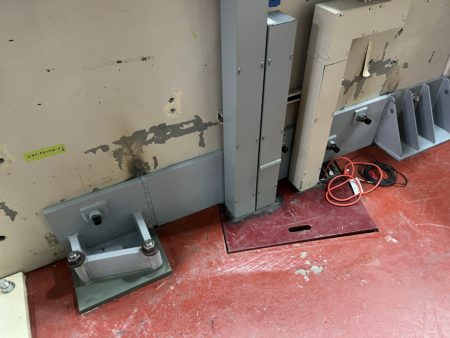The winter 2023 shutdown was relatively short. It started just after the holiday shutdown, and user operations resumed on February 16, delivering on the ALS commitment to minimize shutdown length as much as possible.

Building on projects from the previous shutdown, work continued to install accumulator ring (AR) and transfer line infrastructure and components for ALS-U. Now, almost all support stands for the AR components are in place along the inside of the shielding wall, and the new transfer lines are alongside the existing booster-to-storage-ring transfer line. Space is getting tight!
More work has been done to prepare the area where the new power supply for the booster ring bend magnets will be installed later this year. For ALS-U, the booster ring needs to ramp up to 2 GeV instead of the current 1.9 GeV, necessitating a new power supply. In addition, the new power supply is expected to reduce unplanned operational down times.
Some early work for the storage ring seismic retrofit was also done during the shutdown. This included installation of the first new floor clips and through bolts. The floor clips are attached to the shielding wall and the floor, anchoring the shielding wall. Through bolts go through the shielding wall, connecting the floor clips on either side.

The new power supplies for ALS-U will all be air cooled and reside in new water-cooled racks. The new ALS-U racks have heat exchangers to reject heat and better stabilize the temperature, so the temperature within the rack will be more stable than in the rest of the building. One resulting benefit will be better beam position monitor stability. The cooling water system for this is new, and the installation has started. The main work in this shutdown was to erect scaffolding, since the distribution will be routed close to the overhead crane rails along the building columns.
One raft of AR magnets was installed in the tunnel to test the installation procedures. The raft included magnets, supports, and the vacuum system. Because the magnets had not yet completed final testing, the raft was removed after a few days. Magnet testing will proceed over the next several months, and in the summer shutdown, the team will be able to begin the permanent installation of AR magnets, vacuum systems, and other mechanical components for the AR.

The kicker magnet previously installed in Sector 2 was removed and a new photon mask installed. The kicker was a prototype stripline kicker for ALS-U. Kickers are fast magnets that can go from zero field to full strength in a fraction of the time it takes the beam to go around the ring. They are needed for injection and extraction of the beam. Accelerator operations staff have been troubleshooting an aperture and beam loss problem in Sector 2, and it was feared the kicker might have contributed. Based on inspections and beam tests so far, the removed kicker does not seem to have caused the problem; however, removing it also allows a detailed inspection. Having the prototype installed in the ALS for a while allowed it to go through the thermal cycling that occurs with beam present, so the team can determine whether any improvements are necessary to increase the longevity of the kickers that will be built for ALS-U.
The cold heads on all three superbend magnets have been replaced. The cold heads serve to keep the liquid helium inside the cryostat at a temperature of 4.2 K, which is required to keep them superconducting. Replacing them every 12–18 months is a routine maintenance task, but requires warming up and cooling down the magnets. The manufacturer will refurbish the old ones so they can be reinstalled in the next cycle.
One of the two klystrons for the linac was replaced as it was starting to have low gain (a sign of aging). The two klystrons power the two traveling wave rf structures in the linac, which accelerate the electron beam.